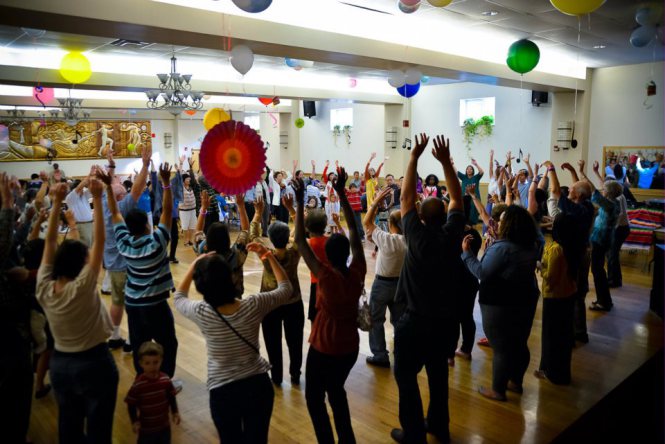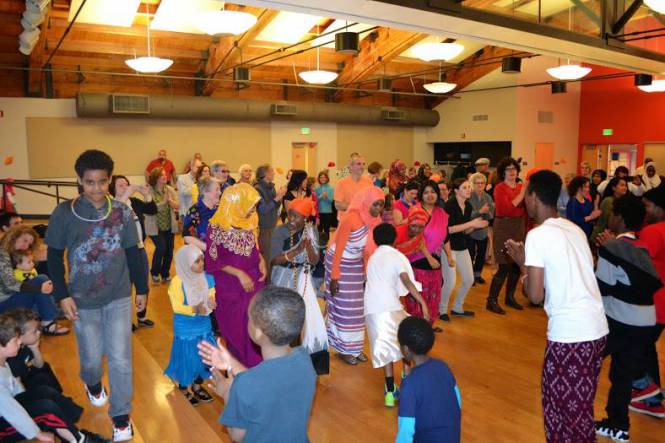 Hi everyone, I am battling a cold right now. I just swallowed two whole cloves of garlic and a shot of fermented pickle brine and some bourbon. (What, like your natural cold remedy is sooo much better!) All that is to say I am feeling woozy and have no clue how coherent this post will be.
Hi everyone, I am battling a cold right now. I just swallowed two whole cloves of garlic and a shot of fermented pickle brine and some bourbon. (What, like your natural cold remedy is sooo much better!) All that is to say I am feeling woozy and have no clue how coherent this post will be.
Today, I want to delve into the need for us as a sector to create opportunities for organic community connections. Since I am going to have another baby arriving in March, I have been thinking of what sort of community I want my kids to grow up in, besides obviously one where hover boards are invented and butternut squash is not on every menu. In many ways, my wife and I are incredibly lucky to be surrounded by a really awesome community. When Viet was born two years ago, our friends formed a meal train, delivering food each week so that we didn’t have to cook for a month. Others handed us bags of used baby clothing, books, and toys. With both sets of our parents being so far away, this community of friends and colleagues helped kept us sane through the difficult first few months, when sleeping for more than three consecutive hours was a luxurious and distant memory.
And yet, it seems in general that our society’s sense of community is waning. Neighbors who live next door to one another may barely interact. Heck, I once lived five years sharing an apartment wall with another family and never learned their names. Ironically, the rise of technology has fueled the distancing between people. Why run next door to your neighbors’ to borrow some sugar, when you can turn to an app to get organic gluten-free evaporated cane juice delivered to your place in under two hours? Why bother with small talk with real people when there are endless amusing videos on youtube, like this one, on how to make a unicorn hoodie?
But all of this distancing comes with a price. The Guardian announces that we have ushered in an Age of Loneliness. According to research they cite, loneliness is twice as deadly as obesity; it is as dangerous as smoking 15 cigarettes a day. It is killing young people and older adults alike. Loneliness, along with sitting, and maybe a zombie apocalypse, will kill all of us.
So, what does that have to do with us in the nonprofit sector? We in this sector are AMAZING at building community, and we may not even realize it. Through our programs and services, we create opportunities for people to interact. We nonprofits combat loneliness and social isolation every day, in addition to the kick-ass other stuff we do. But of course, we don’t talk much about it, and hardly anyone funds it directly, because it seems fluffy when there seems to be so many more serious problems out there. The outcomes around community building are not as tangible or as compelling as other important missions such as fighting education inequity or hunger or climate change.
However, I would argue that this building of community is one of the most important things that we nonprofits do, and we need to understand it and claim our role as leaders in it. When there is a strong sense of community, it’s harder for challenges such as hunger, crimes, and loneliness to take root. As much as I hate the word and concept of nonprofit “sustainability,” if forced into it, I would say that if we want the results of our work to be sustainable into the future, then we need to build community. So we need to focus and plan and push for more funding so we can do it with greater intention.
A bright spot: The World Dance Party
For all of our talks on diversity, inclusion, and cultural competency, I’ve noticed that there is a dearth of opportunities for the awesomeness of diversity to organically  manifest. If we have diverse community members, but they don’t interact, then we’re not really fulfilling the promises of diversity.
manifest. If we have diverse community members, but they don’t interact, then we’re not really fulfilling the promises of diversity.
Currently, diversity manifests in highly formal and prescriptive settings: Summits, boards, focus groups, community forums, etc. On occasions we’ll have a festival where groups can share their cultures with their neighbors. I think those can be good when done right; working on a common goal can really strengthen relationships between people. But with any formality tied to a specific purpose, the relationships often never form beyond what is needed to achieve the goals, and tend to quickly dissipate when the formality ends. What we need to do more often is build community simply for community’s sake.
A few years ago, I helped to found the World Dance Party. This is a giant multicultural, multi-generational potluck community event where diverse instructors teach 20-minute dance lessons and everyone dances. That’s it, there’s no fundraising or cultural competency training or any other agenda besides getting neighbors to show up and eat and dance with one another. At the first event, we had lessons in Bollywood, Salsa, Hip-Hop, line dancing, West African, Disco, and Israeli. We were hoping for 50 people to show up, and we got over 150, of all different ethnicity and ages and dance abilities. Here are some pictures from that event.
It was one of the best days I’ve ever had; it increased my faith in humanity. People of different ethnicity were dancing together; kids and elders were holding hands; I had never felt such a sense of community. It was magical, and I wasn’t the only one who felt that way. A senior stood and watched as the crowd, including several kids, learned some Disco moves. “I’ve never seen this much happiness in one room,” she whispered, in awe.
Seattle has now put on over 12 of these events, about once per quarter, each one attracting 150 to 300 people. World Dance Party has spread to several cities in Washington State. Two weeks ago, World Dance Party Eastside had their first event. 200 people came and learned Flamenco, Hula, Salsa, Bollywood, and Zumba while eating an assortment of interesting potluck contributions. The team in Seattle is starting to plan its 13th WDP event. My wife and I brought our toddler and some friends and their kids. The little ones ran between people’s legs as they practiced a Flamenco dance. No one minded. I ate some hummus and some awful vegetables slices that were smothered in Italian dressing and baked to a crisp. It was inedible, but I was too happy to care.
It’s been going so great and building so much community, that I would love to see World Dance Party spread to other cities and countries. Here, in fact, is the toolkit. Think about organizing an event in your community. Write to worlddanceparty@gmail.com if you need help.
After attending over 10 of these events, I still can’t say what the results/outcomes/metrics are for getting people together to eat and dance. We didn’t measure these things; we never wanted to measure anything beyond whether the events helped neighbors connect to each other. But anyone who has been to one of these WDPs can say with confidence that it has been helping to build the kind of community we all want our kids to grow up in. It’s way better than hover boards. We in the nonprofit sector must be more intentional about creating community, whether through WDP or through other ideas. It’s one of the most important things that we do as a sector.
—
Don’t forget, entries for NWB’s Scary Nonprofit Story contest is due on 10/19. See the bottom of previous post for details.
—
Make Mondays suck a little less. Get a notice each Monday morning when a new post arrives. Subscribe to NWB by scrolling to the top right of this page and enter in your email address. Also, join the NWB Facebook community for daily hilarity.
Discover more from Nonprofit AF
Subscribe to get the latest posts sent to your email.

